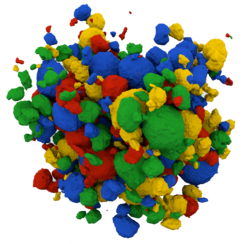Battery Microstructure Project

The microstructure of lithium ion battery (LIB) electrodes and separators can influence battery performance. The LIB community has traditionally relied on a simplified picture of microstructure or computer generated microstructures due to a lack of available experimental microstructural data.
We launched the Battery Microstructure Project to provide 3D microstructural and electrochemical data on porous electrodes and separators. The following microstructures are currently available.
1. NMC-based Porous Electrodes
This external page data archive is hosted by the ETH Zürich Library. Raw and processed data for 16 NMC-based electrodes, prepared with differing amounts of conductive additive and binder and under different compressions along with the corresponding electrochemical data for each electrode. Detailed explanations on how the data was collected and on how to handle the data are found in: external page M. Ebner et al., Adv. Energy Mat. (2013).
2. Polyethylene (PE) Separator
Data archives for a Targray PE16A separator and a Celgard PP1615 separator are hosted by the ETH Zürich Library. Both consist of a binarized image stack with 10 x 10 x 10 nm voxel resolution for a 12 x 7 x 5 µm3 separator volume. Detailed explanations on how the data was collected are found in external page M.F. Lagadec et al. J. Electrochem. Society (2016) Mechanical and electrochemical simulations are discussed in external page M.F. Lagadec et al. J. Electrochem. Society (2018).
3. Commercial Graphite Electrodes
This external page data archive is hosted by the ETH Zürich Library and contains data for 4 commercial graphite electrodes. Detailed explanations on how the data was collected and supporting electrochemical data are found in external page S. Müller et al., J. Electrochem. Soc. (2018).
4. Commercial Anodes (including Tesla, Samsung, Litarion, Sony, and Nanotek)
This external page data archive is hosted by the ETH Zürich Library and provides data for 7 commercial anodes. Detailed explanations on how the data was collected and on how to handle the data are found in P. Pietsch et al., Sustainable Energy Fuels (2018).